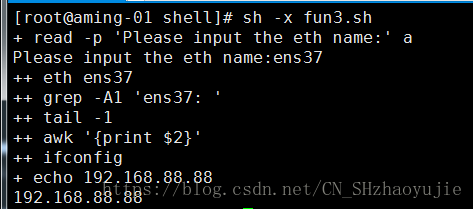shell脚本(中)
内容摘要
- shell中的函数
- shell中的数组
- 告警系统需求分析
- 告警系统主脚本
- 告警系统配置文件
- 告警系统监控项目
- 告警系统邮件引擎
- 运行告警系统
一、shell中的函数
- 函数就是把一段代码整理到了一个小单元中,并给这个小单元起一个名字,当用到这段代码时直接调用这个小单元的名字即可。
- 函数必须定义在调用的代码前。
- 语法格式:
function f_name() {
command
}
- 其中function可以省略不写
- f_name自定义函数名称
- command输入具体的代码
- 示例一:打印对应的参数
#!/bin/bash
function inp(){
echo "The first parameter is $1"
echo "The second parameter is $2"
echo "The third parameter is $3"
echo "The script name is $0"
echo "The number of parameter is $#"
}
inp z x c va xyz
- 其中$1表示第一个参数,$2表示第二个参数,$3表示第三个参数,$0表示脚本名称,$#表示参数的个数
- 也可以将参数放到命令行
#!/bin/bash
function inp(){
echo "The first parameter is $1"
echo "The second parameter is $2"
echo "The third parameter is $3"
echo "The script name is $0"
echo "The number of parameter is $#"
}
inp $1 $2 $3
- 示例二:定义一个加法的函数
#!/bin/bash
sum()
{
s=$[$1+$2]
echo $s
}
sum 2 9
- 示例三:打印出对应的IP
#!/bin/bash
eth()
{
ifconfig |grep -A1 "$1: " |tail -1 |awk '{print $2}'
}
read -p "Please input the eth name:" a
echo "`eth $a`"
二、shell中的数组
数组其实就是变量,只不过变量里面是多个数字或者字符串。
- 定义数组 a=(1 2 3 4 5)
- 调用数组:echo ${a[@]}
- 获取数组的元素个数:echo ${#a[@]}
- 读取第三个元素,数组从0开始计数:echo ${a[2]}
- 显示整个数组:echo ${a[*]} 等同于echo ${a[@]}
- 添加或替换指定下标序列的元素: a[1]=x
- 删除数组:unset a
- 删除对应的元素:unset a[1]
- 数组分片,从第一个元素开始,截取3个:echo ${a[@]:0:3}
- 数组分片,从第二个元素开始,截取4个:echo ${a[@]:1:4}
- 数组分片,从倒数第3个元素开始,截取2个:echo ${a[@]:0-3:2}
- 替换指定元素:echo ${a[@]/3/100} 或者 a=(${a[@]/3/100})
三、告警系统需求分析
- 需求:使用shell定制各种个性化告警工具,但需要统一化管理、规范化管理。
- 思路:指定一个脚本包,包含主程序、子程序、配置文件、邮件引擎、输出日志等。
- 主程序:作为整个脚本的入口,是整个系统的命脉。
- 配置文件:是一个控制中心,用它来开关各个子程序,指定各个相关联的日志文件。
- 子程序:这个才是真正的监控脚本,用来监控各个指标。
- 邮件引擎:是由一个python程序来实现,它可以定义发邮件的服务器、发邮件人以及发件人密码
- 输出日志:整个监控系统要有日志输出。
- 要求:我们的机器角色多种多样,但是所有机器上都要部署同样的监控系统,也就说所有机器不管什么角色,整个程序框架都是一致的,不同的地方在于根据不同的角色,定制不同的配置文件。
- 程序架构:
- bin目录下是主程序
- conf目录下是配置文件
- shares目录下是各个监控脚本
- mail目录下是邮件引擎
- log目录下是日志。
四、告警系统主脚本
- 在目录/usr/local/sbin下创建程序相关的目录
- 创建主目录:mkdir mon
- 进入主目录cd /mon创建下级目录 :mkdir bin conf shares mail log
- 移动至/usr/local/sbin/mon/bin下创建主脚本:vim mail.sh
#!/bin/bash
#Written by aming.
# 是否发送邮件的开关
export send=1
# 过滤ip地址
export addr=`/sbin/ifconfig |grep -A1 "ens33: "|awk '/inet/ {print $2}'`
dir=`pwd`
# 只需要最后一级目录名
last_dir=`echo $dir|awk -F'/' '{print $NF}'`
# 下面的判断目的是,保证执行脚本的时候,我们在bin目录里,不然监控脚本、邮件和日志很有可能找不到
if [ $last_dir == "bin" ] || [ $last_dir == "bin/" ]; then
conf_file="../conf/mon.conf"
else
echo "you shoud cd bin dir"
exit
fi
exec 1>>../log/mon.log 2>>../log/err.log
echo "`date +"%F %T"` load average"
/bin/bash ../shares/load.sh
#先检查配置文件中是否需要监控502
if grep -q 'to_mon_502=1' $conf_file; then
export log=`grep 'logfile=' $conf_file |awk -F '=' '{print $2}' |sed 's/ //g'`
/bin/bash ../shares/502.sh
fi
五、告警系统配置文件
配置文件就是定义监控脚本的开关和相应的日志的路径 主脚本会去过滤配置文件 当监控的服务为1就会执行相应的子脚本
- 移动到conf目录下:cd /usr/local/sbin/mon/conf
- 修改主配置文件:vim mon.conf
## to config the options if to monitor
## 定义mysql的服务器地址、端口以及user、password
to_mon_cdb=0 ##0 or 1, default 0,0 not monitor, 1 monitor
db_ip=10.20.3.13
db_port=3315
db_user=username
db_pass=passwd
## httpd 如果是1则监控,为0不监控
to_mon_httpd=0
## php 如果是1则监控,为0不监控
to_mon_php_socket=0
## http_code_502 需要定义访问日志的路径
to_mon_502=1
logfile=/data/log/xxx.xxx.com/access.log
## request_count 定义日志路径以及域名
to_mon_request_count=0
req_log=/data/log/www.discuz.net/access.log
domainname=www.discuz.net
- 配置文件中任何定义的参数,可以根据需求更改
六、告警系统监控项目
- 进人shares目录:cd /usr/local/sbin/mon/shares
- 创建load.sh 监控系统负载脚本:vim load.sh
#! /bin/bash
##Writen by aming##
load=`uptime |awk -F 'average:' '{print $2}'|cut -d',' -f1|sed 's/ //g' |cut -d. -f1`
if [ $load -gt 10 ] && [ $send -eq "1" ]
then
echo "$addr `date +%T` load is $load" >../log/load.tmp
/bin/bash ../mail/mail.sh [email protected] "$addr\_load:$load" `cat ../log/load.tmp`
fi
echo "`date +%T` load is $load"
- 创建502.sh 监控502脚本:vim 502.sh
#! /bin/bash
d=`date -d "-1 min" +%H:%M`
c_502=`grep :$d: $log |grep ' 502 '|wc -l`
if [ $c_502 -gt 10 ] && [ $send == 1 ]; then
echo "$addr $d 502 count is $c_502">../log/502.tmp
/bin/bash ../mail/mail.sh $addr\_502 $c_502 ../log/502.tmp
fi
echo "`date +%T` 502 $c_502"
- 创建disk.sh监控磁盘使用率脚本:vim disk.sh
#! /bin/bash
##Writen by aming##
rm -f ../log/disk.tmp
for r in `df -h |awk -F '[ %]+' '{print $5}'|grep -v Use`
do
if [ $r -gt 90 ] && [ $send -eq "1" ]
then
echo "$addr `date +%T` disk useage is $r" >>../log/disk.tmp
fi
if [ -f ../log/disk.tmp ]
then
df -h >> ../log/disk.tmp
/bin/bash ../mail/mail.sh $addr\_disk $r ../log/disk.tmp
echo "`date +%T` disk useage is nook"
else
echo "`date +%T` disk useage is ok"
fi
七、告警系统邮件引擎
- 进入mail目录:cd /usr/local/sbin/mon/mail
- 创建发邮件脚本:vim mail.py
#!/usr/bin/env python
#-*- coding: UTF-8 -*-
import os,sys
reload(sys)
sys.setdefaultencoding('utf8')
import getopt
import smtplib
from email.MIMEText import MIMEText
from email.MIMEMultipart import MIMEMultipart
from subprocess import *
def sendqqmail(username,password,mailfrom,mailto,subject,content):
gserver = 'smtp.qq.com'
gport = 25
try:
msg = MIMEText(unicode(content).encode('utf-8'))
msg['from'] = mailfrom
msg['to'] = mailto
msg['Reply-To'] = mailfrom
msg['Subject'] = subject
smtp = smtplib.SMTP(gserver, gport)
smtp.set_debuglevel(0)
smtp.ehlo()
smtp.login(username,password)
smtp.sendmail(mailfrom, mailto, msg.as_string())
smtp.close()
except Exception,err:
print "Send mail failed. Error: %s" % err
def main():
to=sys.argv[1]
subject=sys.argv[2]
content=sys.argv[3]
##定义QQ邮箱的账号和密码,你需要修改成你自己的账号和密码(请不要把真实的用户名和密码放到网上公开,否则你会死的很惨)
sendqqmail('[email protected]','aaaaaaaaaa','[email protected]',to,subject,content)
if __name__ == "__main__":
main()
#####脚本使用说明######
#1. 首先定义好脚本中的邮箱账号和密码以及邮箱服务器
#2. 脚本执行命令为:python mail.py 目标邮箱 "邮件主题" "邮件内容"
- 创建mail.sh 调用发邮件和告警收敛的脚本:vim mail.sh
#把mail.sh的第二个参数赋值给log
log=$2
#当前时间的时间戳
t_s=`date +%s`
#两小时前的时间戳
t_s2=`date -d "2 hours ago" +%s`
if [ ! -f /tmp/$log ]
then
#创建记录时间戳的日志
echo $t_s2 >/tmp/$log
fi
#把时间戳日志里的时间戳赋值给t_s2
t_s2=`tail -1 /tmp/$log |awk '{print $1}'`
#把当前时间的时间戳添加到计时器日志里去
echo $t_s >>/tmp/$log
#当前时间戳和上一次的时间戳的差
v=$[$t_s-$t_s2]
echo $v
if [ $v -gt 3600 ]
then
./mail.py $1 $2 $3
#定义报警计数器日志/清零计数器日志
echo "0" > /tmp/$log.txt
else
if [ ! -f /tmp/$log.txt ]
then
echo "0" > /tmp/$log.txt
fi
nu=`cat /tmp/$log.txt`
nu2=$[$nu+1]
echo $nu2>/tmp/$log.txt
if [ $nu2 -gt 10 ]
then
./mail.py $1 "trouble continue 10 min $2" $3
echo "0">/tmp/$log.txt
fi
fi
- 其中/tmp/$log是计时器日志 /tmp/$log.txt是计数器日志
- 第一次执行mail.sh t_s是当前时间戳 t_s2是两个小时前的时间戳 判断差值大于3600s 发邮件 并计数器为0
- 1分钟后再次执行mail.sh t_s是当前时间戳 t_s2为1分钟前的时间戳判断差值小于3600s 计数器为1
- 每分钟都执行mail.sh 到了第11分钟 因为 t_s和t_s2之前的差值都是小于3600s是不会发邮件的 当时 此时计数器为11 大于10 就发一份“问题持续10分钟”的邮件 并计数器清零
- 假如超多一个小时后再此执行mail.sh t_s和t_s2的时间戳 判断差值大于3600s 就会发邮件并会清空原来的计数器
八、运行告警系统
- 定义计划任务:crontab -e
* * * * * cd /usr/local/sbin/mon/bin;bash main.sh
- 在实际运用中,可以自行调整参数脚本。根据实际需求监控对应的项目。











